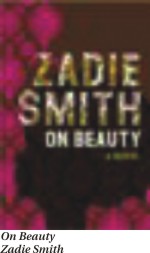|
Book Review
A thing of Beauty
Stephanie Merritt
Even if she had not made it explicit in her acknowledgments, Zadie Smith's homage to EM Forster's Howards End announces itself in the opening line of her third novel: 'One may as well begin with Jerome's emails to his father.' It would be reductive to call On Beauty an updating of Forster's novel - configurations of relationships are altered, melodrama excised, new themes introduced - but the central concerns of Howards End, the conflict between two families of opposing political and moral sensibilities, issues of class, behaviour, ambition and opportunity in a society with proscribed rules and roles, are also the framework that supports Smith's exceptionally accomplished novel.
 To simulate the stratified society of Forster's turn-of-the-century England, Smith has chosen an equally hidebound world, the knowingly archaic and insular landscape of an upscale, east coast American university outside Boston, not dissimilar to Harvard, where the author spent time on a visiting fellowship. Wellington College, with its petty feuds, judgments, professional and sexual jousting and self-congratulating affluence, prides itself on its liberal principles but remains almost wholly estranged from a world in which prejudice, poverty, crime, terror and fear are the forces that move those outside the academic bubble. To simulate the stratified society of Forster's turn-of-the-century England, Smith has chosen an equally hidebound world, the knowingly archaic and insular landscape of an upscale, east coast American university outside Boston, not dissimilar to Harvard, where the author spent time on a visiting fellowship. Wellington College, with its petty feuds, judgments, professional and sexual jousting and self-congratulating affluence, prides itself on its liberal principles but remains almost wholly estranged from a world in which prejudice, poverty, crime, terror and fear are the forces that move those outside the academic bubble.
Smith has added an extra dimension to Forster's scrutiny of class by stirring elements of race and nationality into the mix; how far blackness determines identity is a question asked by most of her characters at one time or another. Many are also troubled by the question of the use or value of art and literature in a post-9/11 world where all established values seem to have been upended; neither the 'high' culture of the academy, nor the 'low' culture of the street escape this interrogation, while the notion of distinguishing between them is also dissected.
At the centre of the novel is the Belsey family. Howard, 57, is a world-weary, liberal academic whose work, a deconstruction of the myth of Rembrandt's genius, has never quite had the impact on the wider world that he might have wished. Married to Kiki, a warm-hearted, generously proportioned black woman from Florida, middle class in her own right but without his academic education, he is the father of three children, earnest Jerome, 20, insecure Zora, 19, and Levi, who, at 16, is rebelling against his background and will only speak in the cadences of gangsta rap.
Howard and Kiki's 30-year marriage is recovering from the blow dealt by Howard's brief affair with a colleague and family friend, poet Claire Malcolm, when his professional confidence is also assailed by the discovery that his long-time academic rival, Sir Montague Kipps, is to take up a teaching post at Wellington College. Kipps is a Caribbean-born conservative who still refers to 'the coloured man', is opposed to affirmative action and intends to deliver a series of lectures entitled 'Taking the liberal out of liberal arts'. Jerome, too, is horrified at the news; the year before, he fell in love with Kipps's beautiful daughter, Victoria.
In a previous essay on Forster, Smith wrote: 'There is no bigger crime in the English comic novel than thinking you are right.' This is a lesson painfully learnt by all her characters, but she goes on to say that it is a lesson that must also apply to the comic novelist. 'They, too, require educated hearts to do their work and avoid caricature; they must understand not only what the brain knows, and what other people know, but also what love knows.' Kiki is the beating heart of this novel; despite repeated assertions, authorially and personally, that she is not an intellectual, she is the most forceful personality in this nest of intellectuals; Howard, by contrast, is revealed in all the paucity of his heart and will in his desperate scrabblings after sexual adventure and his refusal to attach an affective value to anything.
As with her debut White Teeth, On Beauty is wonderfully funny. From the perfectly nuanced dialogue of young black men to the refined aesthetic wranglings of art historians, Smith displays a remarkable talent for embracing all the possibilities of language, and time and again she produces images that shout out in their brilliance: 'Tom turned away to gulp his laugh down like an aspirin'; a dead woman at a wake 'was presently being piously preserved in the aspic of low voices and bland anecdote, pickled in perfection'. Others, it must be said, strive a little too hard: 'The daily miracle whereby interiority opens out and blooms into the million-petalled flower of being here, in the world, with other people.' Again, as with White Teeth, there is a sense that the book could have benefited from more stringent editing purely in terms of length and narrative movement.
It seems odd to have reproduced published poems by her husband, Nick Laird, in the book and given them to Claire, but with this quibble aside, On Beauty confirms Smith as an outstanding novelist with a powerful understanding both of what the brain knows and of what love knows, especially when it comes to families.
This review was published on the Guardian.
Copyright
(R) thedailystar.net 2005 |
